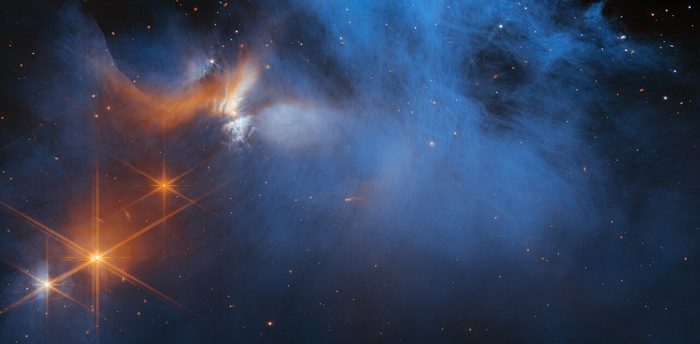SAN ANTONIO — Jan. 23, 2023 —An international team including Southwest Research Institute, Leiden University and NASA used observations from the James Webb Space Telescope (JWST) to achieve the darkest ever view of a dense interstellar cloud. These observations have revealed the composition of a virtual treasure chest of ices from the early universe, providing new insights into the chemical processes of one of the coldest, darkest places in the universe as well as the origins of the molecules that make up planetary atmospheres.

Credit: NASA/ESA/CSA/M. Zamani (ESA/Webb)/M. K. McClure (Leiden Observatory)/F. Sun (Steward Observatory)/Z. Smith (Open University)/Ice Age ERS Team
SAN ANTONIO — Jan. 23, 2023 —An international team including Southwest Research Institute, Leiden University and NASA used observations from the James Webb Space Telescope (JWST) to achieve the darkest ever view of a dense interstellar cloud. These observations have revealed the composition of a virtual treasure chest of ices from the early universe, providing new insights into the chemical processes of one of the coldest, darkest places in the universe as well as the origins of the molecules that make up planetary atmospheres.
“The JWST allowed us to study ices that exist on dust grains within the darkest regions of interstellar molecular clouds,” said SwRI Research Scientist Dr. Danna Qasim, co-author of the study published in Nature Astronomy. “The clouds are so dense that these ices have been mostly protected from the harsh radiation of nearby stars, so they are quite pristine. These are the first ices to be formed and also contain biogenic elements, which are important to life.”
NASA’s JWST has a 6.5-meter-wide mirror providing remarkable spatial resolution and sensitivity, optimized for infrared light. As a result, the telescope has been able to image the densest, darkest clouds in the universe for the first time.
“These observations provide new insights into the chemical processes in one of the coldest, darkest places in the universe to better understand the molecular origins of protoplanetary disks, planetary atmospheres, and other Solar System objects,” Qasim said.
Most interstellar ices contain very small amounts of elements like oxygen and sulfur. Qasim and her co-authors seek to understand the lack of sulfur in interstellar ices.
“The ices we observed only contain 1% of the sulfur we’re expecting. 99% of that sulfur is locked-up somewhere else, and we need to figure out where in order to understand how sulfur will eventually be incorporated into the planets that may host life,” Qasim explained.
In the study, Qasim and colleagues propose that the sulfur may be locked in reactive minerals like iron sulfide, which may react with ices to form the sulfur-bearing ices observed.
“Iron sulfide is a highly reactive mineral that has been detected in the accretion disks of young stars and in samples returned from comets. It’s also the most common sulfide mineral in lunar rocks,” Qasim said. “If sulfur is locked-up in these minerals, that could explain the low amount of sulfur in interstellar ices, which has implications for where sulfur is stored in our Solar System. For example, the atmosphere of Venus has sulfur-containing molecules, in which the sulfur could have partially come from interstellar-inherited minerals.”
The paper, “An Ice Age JWST inventory of dense molecular cloud ices,” appears in Nature Astronomy: https://www.nature.com/articles/s41550-022-01875-w
For more information, visit https://www.swri.org/planetary-science.
Journal
Nature Astronomy
DOI
10.5281/zenodo.7501239
Method of Research
Observational study
Subject of Research
Not applicable
Article Title
An Ice Age JWST inventory of dense molecular cloud ices
Article Publication Date
23-Jan-2023




